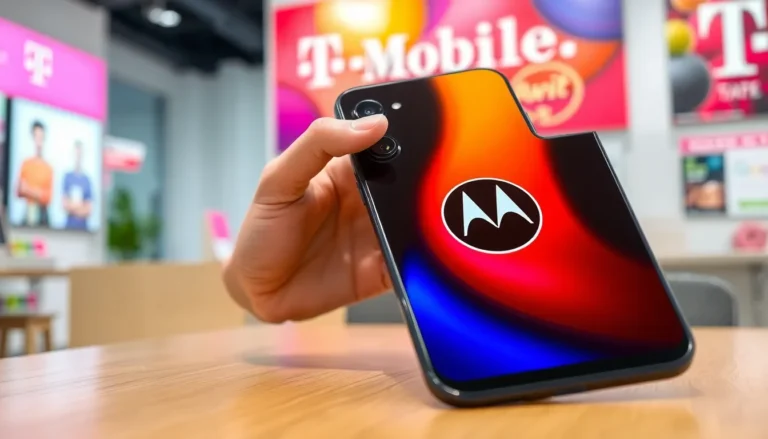Mobile gaming has taken the world by storm, turning casual players into dedicated fans faster than you can say “level up!” With a device in nearly every pocket, gaming isn’t just for couch potatoes anymore. It’s for anyone who loves a good challenge, whether they’re waiting in line for coffee or pretending to pay attention in a meeting.
Table of Contents
ToggleOverview Of Mobile Gaming
Mobile gaming has rapidly evolved into a dominant force in the gaming industry. Millions of players engage daily with a diverse range of games on their smartphones and tablets. Game developers continue to create titles tailored for mobile devices, ensuring accessibility for casual and dedicated gamers alike.
Statistics indicate that in 2021, mobile gaming generated approximately $175 billion in revenue, accounting for nearly 50% of the global gaming market. This revenue reflects the widespread appeal of mobile platforms, which cater to various demographics, from young children to adults.
Mobile games encompass a variety of genres, including action, puzzle, strategy, and role-playing. Players often prefer these games for their convenience and portability, allowing them to play on-the-go. Popular titles such as “Candy Crush Saga,” “PUBG Mobile,” and “Fortnite” exemplify this trend, drawing millions of active users.
Technological advancements contribute significantly to the growth of mobile gaming. Improved smartphone capabilities, such as enhanced graphics, faster processors, and better connectivity, allow for more complex and visually appealing games. In addition, the rise of cloud gaming enables players to access high-quality gaming experiences without the need for expensive hardware.
The social aspect of mobile gaming fosters community engagement. Many games incorporate features that allow players to connect with friends or compete against others worldwide. This interaction builds a sense of camaraderie and motivates players to engage more frequently with their favorite titles.
As mobile gaming continues to advance, developers prioritize innovation and user experience. The increasing focus on augmented and virtual reality in mobile gaming indicates a promising future for this segment, further expanding gaming possibilities.
Popular Mobile Gaming Genres

Mobile gaming features numerous genres appealing to various player preferences. Each genre provides unique experiences and attracts millions of players worldwide.
Casual Games
Casual games capture attention with simple mechanics and engaging gameplay. Titles like “Candy Crush Saga” and “Angry Birds” dominate this genre, attracting casual players looking for short gaming sessions. Players enjoy these games during breaks or while commuting, making them easily accessible. Often characterized by bright graphics and easy-to-understand rules, casual games encourage daily play. Statistics revealed that casual gaming contributed significantly to the $175 billion revenue in the mobile gaming sector. These games create an inviting atmosphere, appealing to players of all ages and skill levels.
Action and Adventure Games
Action and adventure games deliver excitement and thrill, immersing players in dynamic environments. Popular titles such as “PUBG Mobile” and “Fortnite” draw millions of players into competitive experiences. Fast-paced gameplay and intricate storylines keep players engaged and returning for more. Enhanced graphics and realistic controls leverage advanced smartphone capabilities, providing thrilling visuals and responsive actions. These games encourage social interaction, making it easy for friends to team up and compete. As players navigate challenges and intense battles, they become part of an expansive community that shares strategies and experiences.
Role-Playing Games
Role-playing games (RPGs) offer immersive storytelling and character progression that resonates deeply with players. Games like “Genshin Impact” and “Final Fantasy XV Pocket Edition” allow users to build unique characters and explore expansive worlds. Players often invest significant time in character development and quest completion, enhancing their gaming experience. These RPGs incorporate rich narratives and detailed graphics, drawing players into fantastical realms. Data shows RPGs remain popular across all demographics, highlighting their broad appeal in the mobile gaming landscape. Engaging gameplay mechanics and community-driven content contribute to their ongoing success and longevity.
The Impact Of Mobile Gaming
Mobile gaming affects various aspects of life and entertainment. Its rise has led to significant changes in social interaction and cognitive benefits for players.
Social Interaction
Mobile gaming enhances social engagement among players. Many games incorporate features that allow friends to connect, compete, and collaborate, fostering a sense of community. It serves as a platform for players to share experiences in real-time, whether through cooperative missions or competitive matches. With millions participating daily, games like “Among Us” and “Call of Duty: Mobile” create opportunities for communication and teamwork. Players can also join online forums or social media groups to discuss strategies or share achievements, strengthening relationships beyond the game itself. The ability to connect with people globally encourages a diverse range of interactions, bridging gaps between players from different backgrounds.
Cognitive Benefits
Mobile gaming contributes positively to cognitive development. Engaging in various game types can aid problem-solving skills and improve memory. Puzzle games like “Candy Crush Saga” challenge players to think critically and develop strategies, increasing mental agility. Research suggests that players often enhance their multitasking abilities while navigating complex game scenarios. Role-playing games (RPGs) require players to immerse themselves in narratives and character development, promoting empathy and emotional intelligence. Studies show that gaming can sharpen reaction times and improve decision-making skills, particularly in fast-paced action games. Combining entertainment with cognitive challenges highlights mobile gaming’s potential as a tool for mental growth.
Mobile Gaming Trends
Mobile gaming continues to evolve rapidly, reflecting advancements in technology and changing player preferences. Several key trends shape the landscape of this industry.
Cloud Gaming
Cloud gaming represents a significant shift in how players access games on mobile devices. By leveraging cloud technology, players can stream high-quality games without the need for powerful hardware. The convenience of playing on any device enhances accessibility, appealing to a broader audience. In 2021, the global cloud gaming market reached over $1 billion, with projections indicating strong growth in the coming years. Companies like NVIDIA and Google have developed platforms that support seamless gameplay, reducing loading times significantly. Gamers can enjoy titles previously only available on consoles or PCs directly on their phones and tablets, transforming daily gaming sessions.
Augmented Reality Integration
Augmented reality (AR) brings a unique dimension to mobile gaming, enhancing player engagement. By blending digital elements with the real world, AR creates immersive experiences that captivate users. Popular titles such as “Pokémon GO” have demonstrated the potential of AR, achieving over 400 million downloads worldwide. AR not only encourages physical activity but also fosters social interaction as players often team up to accomplish in-game objectives. As AR technology continues to improve, developers are integrating more sophisticated features, creating games that promote collaboration and exploration. This integration paves the way for innovative gameplay mechanics, driving interest and investment in the mobile gaming sector.
Challenges In Mobile Gaming
Mobile gaming faces several challenges that affect both developers and players.
Device Fragmentation
Device fragmentation presents significant hurdles in mobile gaming. Diverse operating systems and screen sizes lead to inconsistencies in user experience. Companies must develop games compatible with a wide array of devices, complicating the design process. For instance, optimizing graphics for high-end smartphones while ensuring functionality on budget models may require extra resources. In 2021, Android devices accounted for about 72% of the mobile market, emphasizing the need for cross-platform capabilities. Developers often struggle to balance performance and quality across various devices, sometimes alienating players with older hardware.
In-Game Purchases
In-game purchases often create friction among mobile gamers. While these features fuel revenue, they can lead to frustration over paywalls and competitive advantages. A significant percentage of players, about 65%, report annoyance over aggressive monetization strategies in games like “Fortnite” and “Candy Crush Saga.” Players may feel pressured to spend money, which can detract from enjoyment. Transparency is key; players appreciate clear information regarding the value and necessity of in-game purchases. Developers face a delicate balance in integrating these features without sacrificing gameplay immersion.
Mobile gaming has undeniably reshaped the gaming landscape by making it accessible to a vast audience. With its impressive revenue growth and diverse genres, it caters to players of all ages and interests. The integration of advanced technologies like cloud gaming and augmented reality continues to enhance user experiences and engagement.
As the community around mobile gaming grows, it not only entertains but also fosters social connections and cognitive development. Despite facing challenges like device fragmentation and monetization issues, the future of mobile gaming looks bright. Developers are likely to keep innovating, ensuring that this dynamic sector remains at the forefront of the gaming industry.




